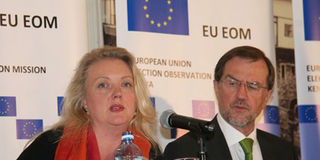Presidential poll was not rigged, say EU observers

PHOTO | JENNIFER MUIRURI European Union Election Observation Mission(EUEOM) deputy chief observer Gillian McCormack (left) with chief observer Alojz Peterle at a press conference during which EUEOM released the 2013 general election report on May 29, 2013.
What you need to know:
- Discrepancies in number of votes cast in different races were due to errors by election officials who were under pressure
- Observers carried out comparisons based on sets of results obtained at the close of tallying or afterwards
- Tallying of results was not transparent, beginning with the absence of detailed procedural guidelines in the public domain
Discrepancies in number of votes cast in presidential and other races in the March 4 poll were not as a result of fraud, says the European Union.
Instead, the union believes, they were caused by tallying errors by election officials who were under pressure to do their jobs.
In its final report on the elections released on Wednesday, the EU Elections Observer Mission says even though it noted widespread minor discrepancies in the tallies, the differences were less than one per cent.
“This can be accounted for on the whole by tallying errors, as intention to cheat would normally be indicated by much larger differences in the numbers,” says the report released by Chief Observer Alojz Peterle. “There was no overall pattern favouring one candidate or another…The one per cent figure tends to imply tallying errors rather than fraud.”
The observers carried out comparisons based on sets of results obtained at the close of tallying or afterwards.
“These revealed relatively small inconsistencies, particularly between results announced at the constituency or county level, as compared with official results published at the national level,” reads the report. “This may be explained by insufficient clear procedures and training, inadequate tools and human error under pressure.”
Tallying of results, the document says, was not transparent, beginning with the absence of detailed procedural guidelines in the public domain.
Even though observers and party agents had access to constituency and county tallying centres, it says, they could not closely follow the process.
Mr Peterle pointed out the failure on the application of technology as one of the major let-downs of the election. This, he said, was due to the attempt to introduce new technology less than a year and in some cases, months prior to the elections.
The observers also reveal Electronic Voter Identification Devices were not working or were used in about half the polling stations they observed.




